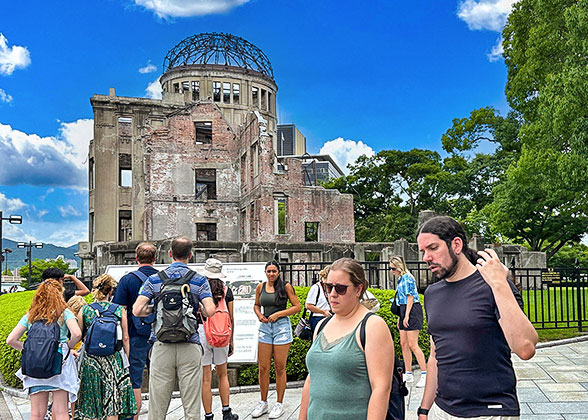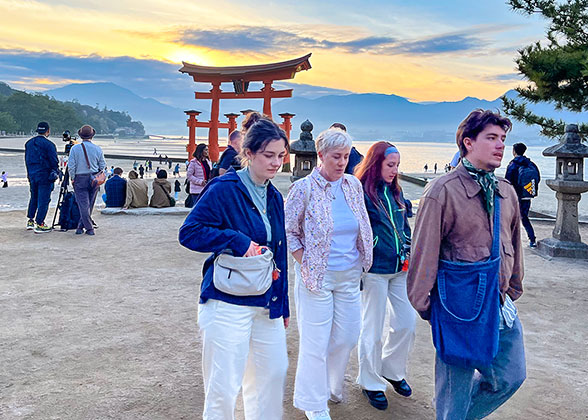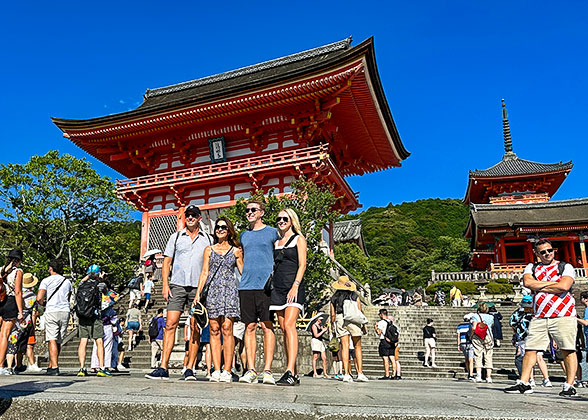Hiroshima Attractions
Hiroshima Japan, is the first city in the world being attacked by a nuclear weapon. The Atomic Bomb Dome has been listed as the world's cultural heritage, which shows the terrible consequences of the atomic bomb and indicates the resolute rejection of nuclear weapons. In addition, natural attractions in Hiroshima also attract countless visitors, like Itsukushima Shrine and Mountain Misen. The red giant torii standing on the sea is the landmark of the Itsukushima Shrine, and Daisho-in Temple in Mountain Misen also is a nice scene. Furthermore, you can see lovely deer and monkeys on Miyajima Island.The Must-visit Attractions around Miyajima Island
Miyajima Island is a top tourist destination of Hiroshima, and is regarded as one of the three most famous places in Japan. The island boasts natural attractions and cultural attractions, like Itsukushima Shrine, Mountain Misen, and Daisho-in Temple. You can take the JR Miyajima Ferry from Miyajimaguchi to Miyajima Island, which takes about 10 minutes.1. Itsukushima Shrine
The Itsukushima Shrine is the landmark of the island and it is dedicated to the three sea goddesses in ancient Japanese legends. The huge red torii with 16 meters (52 feet) high in the sea is the sign of the Itsukushima Shrine. The torii is made of lignum cinnamomi camphorae which has natural corrosion resistance. When the tide goes out, you can take a photo with the complete tori. Besides, there is a water stage in the shrine, where the Japanese Noh performance is given.

Itsukushima Shrine
|
2. Mountain Misen
The huge stones and ancient temple make up Mountain Misen. It is also a natural plant museum and you have the opportunity to see deer and monkeys on the climb. The mountain has three different hiking trails, each of which takes about 1.5-2 hours to complete. You can also take a cable car to the top of the mountain.3. Daisho-in Temple
Daisho-in Temple is the oldest temple on Miyajima Island. On the way to the temple, you can see many small stone Buddha statues with red hats. It is said that there is a fire called an unquenchable fire that has been burning for more than 1,200 years in the temple. Besides, you can experience meditation, copying the sutra, painting Buddha images, and other courses.Top Attractions to Visit around the Center of Hiroshima
1. Atomic Bomb Dome
Atomic Bomb Dome is a western style building that survived the atomic bombing and is located in the center of Hiroshima. When the atomic bomb exploded, almost all buildings within 2 kilometers (1.2 miles) were reduced to ashes. But buildings within a vertical distance of 600 meters (656 yards) from the center of the blast remained standing. The building was listed as a World Heritage Site in 1996. You can visit the building for free from outside, but are not allowed to enter it.

Atomic Bomb Dome
|
2. Hiroshima Castle
The castle is one of the 100 most famous castles in Japan. It was originally built in 1589 and was completely destroyed by atomic bombing in 1945. The current Main Keep in the castle was rebuilt in 1958 and is used as a museum to show the history of Hiroshima before it was destroyed by the atomic bombing. There are three special trees that survived the atomic bomb, and they are only 740 meters (809 yards) to 910 meters (995 yards) from the blast center.

Hiroshima Castle
|
3. Hiroshima Peace Memorial Park
The park was established in 1950, hosting about 70 monuments that record the names of the victims of the Hiroshima nuclear bombing. The Peace Memorial Museum in the park documents the negative influence of the nuclear explosion.

Hiroshima Peace Memorial Park
|
4. Hiroshima Peace Memorial Museum
Hiroshima was the first place in the world that suffered from an explosion of atomic bombs. Peace Memorial Museum collects and shows remains of the atomic bomb and countless photographs and materials of the atomic bomb damage. Peace Memorial Museum aims to make people around the world realize the enormous and lasting damage of nuclear weapons.

Hiroshima Peace Memorial Museum
|
5. Hondori Street
Hondori Street is close to the Hiroshima Peace Memorial Park and it symbolizes the prosperity of Hiroshima. The street is about 577 meters (631 yards) long from east to west and it has more than 200 stores that sell varied foods and goods. The street is covered by glass ceiling and you can enjoy shopping in the rain or snow.

Hondori Street
|
6. Shukkeien Garden
It is a traditional Japanese Garden over 400 years old, but the current garden was rebuilt in 1949 and opened to the public in 1951. There are many small islands in the garden, and a rockery modeled after Mount Fuji. Standing on the top of the rockery, you can overlook the whole park. Besides, you can appreciate cherry blossoms and peach blossoms during March and April, red maple in October, and plum blossoms and camellias during December.7. Hijiyama Park
The park is an artistic park and is located on a small hill about 70 meters high, allowing you to overlook the city view of Hiroshima and the landscape of Seto-naikai. During the spring, more than 1,000 cherry trees in the south of the park are in bloom. You also can find the Museum of Modern Art and Hiroshima Cartoon Library in the north of the park.More Attractions to Visit around Hiroshima
1. Ōkunoshima
Ōkunoshima is an island full of hares, and visitors can feed and interact with these hares. There was once a secret biological weapons factory on the island. Now, there is a museum on the island that shows the past secret of producing poison gas, and you also can find some military base sites on the island.2. Yamato Museum
Nicknamed Kure Maritime Museum, the museum displays rich naval ordnance during World War II. The model of the Japanese battleship Yamato is the star exhibit. Japanese battleship Yamato was once the largest ship in the world in 1940, and it was sunk in 1945. Based on blueprints and photographs, the museum has created an accurate model of the Yamato at a scale of 1:10.
See more:
You May Like
-
 7 Days Mini Group Tour with Highlights in Japan: Tokyo - Mt. Fuji - Kyoto - Nara - Osaka from USD2155
7 Days Mini Group Tour with Highlights in Japan: Tokyo - Mt. Fuji - Kyoto - Nara - Osaka from USD2155 -
 10 Days Private Tour of Tokyo - Mt. Fuji - Nagoya - Takayama - Shirakawa-go - Kanazawa - Kyoto - Nara - Hiroshima - Osaka from USD3809
10 Days Private Tour of Tokyo - Mt. Fuji - Nagoya - Takayama - Shirakawa-go - Kanazawa - Kyoto - Nara - Hiroshima - Osaka from USD3809 -
 8 Days Japan Mini Group Tour to Tokyo - Hakone & Mt. Fuji - Kyoto - Nara - Osaka - Hiroshima - Osaka from USD2771
8 Days Japan Mini Group Tour to Tokyo - Hakone & Mt. Fuji - Kyoto - Nara - Osaka - Hiroshima - Osaka from USD2771


